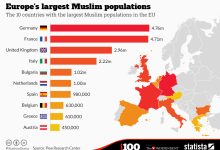The Population of Sinai: A Comprehensive Analysis
The Sinai Peninsula, located in Egypt, is a region steeped in history and cultural significance. It serves as a bridge between Africa and Asia, bordered by the Mediterranean Sea to the north and the Red Sea to the south. This unique geographical positioning has influenced its demographic patterns significantly. This article delves into the population of Sinai, examining its composition, distribution, challenges, and socio-economic factors.
Historical Context
Understanding the population dynamics of Sinai requires a historical perspective. The region has been inhabited for millennia, with evidence of ancient civilizations including the Egyptians, Hebrews, and various nomadic tribes. Throughout history, Sinai has been a focal point for trade and pilgrimage, particularly due to its proximity to key religious sites such as Mount Sinai. These historical interactions have shaped the cultural fabric of the region, contributing to its diverse population.
Demographic Overview
As of recent estimates, the population of Sinai is approximately 600,000, although exact figures can vary due to the region’s complex socio-political landscape. The population is concentrated mainly in the northern part of the peninsula, particularly in towns such as El Arish, Rafah, and Sheikh Zuweid. The southern region, including cities like Sharm El Sheikh and Dahab, attracts a significant number of tourists, which also influences its demographic trends.
Ethnic and Cultural Composition
The population of Sinai is predominantly Arab, with a mix of Bedouin tribes who have historically inhabited the region. The Bedouins, known for their nomadic lifestyle, have a rich cultural heritage that contributes to the social diversity of Sinai. Additionally, there are small communities of Copts, especially in the more populated northern areas, reflecting the broader demographic trends seen throughout Egypt.
Population Distribution
The distribution of the population in Sinai is uneven, with the northern regions being more densely populated compared to the south. The proximity to the Gaza Strip and the Mediterranean coast has made northern Sinai an area of strategic importance, leading to increased military and economic presence. This has implications for population growth and stability, as well as for the livelihoods of local residents.
Socio-Economic Factors
The socio-economic conditions in Sinai are influenced by several factors, including geography, political stability, and economic opportunities. While tourism is a significant economic driver, particularly in the southern region, northern Sinai faces challenges due to security issues related to regional conflicts and insurgency. This has led to economic stagnation in certain areas, impacting population growth and stability.
Agriculture is another vital sector for the Sinai population, with the region’s fertile land supporting crops such as citrus fruits, olives, and vegetables. However, agricultural practices are often challenged by water scarcity and climatic conditions, necessitating innovative solutions to ensure food security.
Challenges Facing the Population
The residents of Sinai face various challenges, including security concerns, limited infrastructure, and inadequate access to healthcare and education. The ongoing military operations against extremist groups have created a sense of instability, impacting daily life and economic activities. Moreover, the lack of investment in infrastructure hampers the region’s development potential, leading to disparities in quality of life compared to other parts of Egypt.
The Future of Sinai’s Population
Looking ahead, the population of Sinai is likely to continue evolving, influenced by socio-political changes and economic developments. The Egyptian government has recognized the importance of Sinai in national development plans, leading to initiatives aimed at enhancing infrastructure, promoting tourism, and improving local livelihoods. These efforts could foster a more stable and prosperous environment for residents.
Conclusion
The population of Sinai is a complex tapestry of cultures, histories, and socio-economic realities. As the region navigates its unique challenges and opportunities, understanding its demographic landscape becomes essential for fostering sustainable development. The interplay between history, culture, and modern socio-economic factors will continue to shape the lives of those who call Sinai home, making it a region of both historical significance and contemporary relevance.
In conclusion, while the current population figures present a snapshot of Sinai, the dynamics are ever-changing, reflecting broader trends within Egypt and the region. Continued attention to the needs and aspirations of the Sinai population will be crucial in promoting stability and prosperity in this historically rich and strategically important area.

